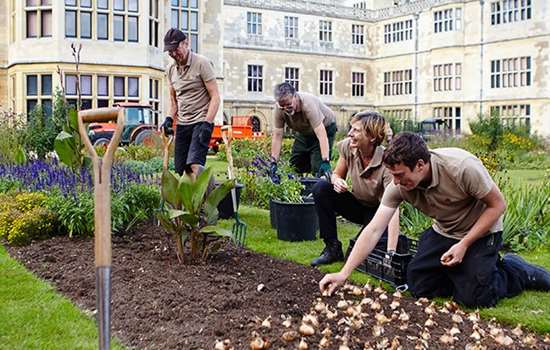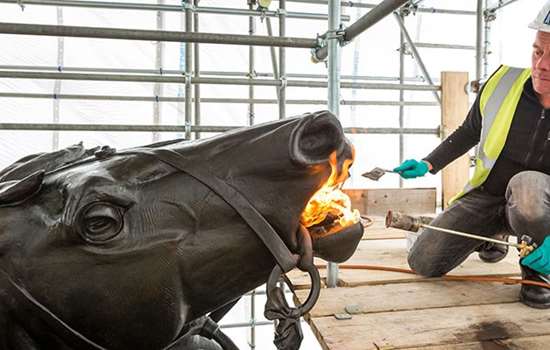24/02/2016
Future secure for industrial icon
The world’s first iron bridge will be repaired as part of a major conservation project, English Heritage have announced, in what will be the new charity’s single largest conservation project to date.
Erected in 1779 over the River Severn in Shropshire, the cradle of the Industrial Revolution, the Iron Bridge was the first single span arch bridge in the world to be made of cast iron and was a turning point in British engineering as cast iron became widely used in the construction of bridges and buildings.
However Britain’s best-known industrial monument is suffering from cracking due to stresses in the ironwork dating from the original construction, ground movement over the centuries, and an earthquake at the end of the 19th century.
English Heritage’s major conservation programme will see the different elements of the bridge – the iron radials and braces holding the bridge together, the deck plates and wedges, the main iron arch, and the stone abutments on either side of the Severn – examined and repaired. The cast iron pieces will be carefully cleaned and conserved, re-installed or replaced where absolutely necessary. As part of the project, the bridge will be re-painted.
English Heritage’s Chief Executive, Kate Mavor, said: “Iron Bridge is one of the wonders of the modern world. An iconic symbol of the Industrial Revolution, it is arguably the most important bridge ever built and without doubt, one of the most important sites in our care. This conservation project will ensure that both its revolutionary structure and the story those cast iron arches and beams tell, will continue to inspire us for generations to come.”
English Heritage became an independent charity in April 2015 and is embarking on the largest conservation programme in the history of the collection of sites and monuments in its care. The conservation programme will promote traditional heritage and conservation skills and English Heritage aims to establish a new in-house team of expert craftspeople.
The conservation of Iron Bridge follows three years of surveys and investigations that conclude this week with engineering experts surveying the bridge, sometimes abseiling from the bridge. Work on Iron Bridge is expected to start in 2017.
The bridge gave its name to the spectacular wooded gorge that was once an industrial powerhouse. Ironbridge Gorge is now a World Heritage Site and the bridge is free to visit.
Notes to Editors:
The world's first iron bridge was erected over the River Severn in Shropshire in 1779. This pioneering single-span cast-iron structure was a turning point in British design and engineering; after it was built, cast iron came to be widely used in bridges, aqueducts and buildings.
Although this symbol of the Industrial Revolution sits in what is today a rural area, in the late 18th century this part of Shropshire was an industrial powerhouse because of its rich coal deposits near the surface.
In 1709, Abraham Darby I, a former brass founder from Bristol, had begun to smelt local iron ore with coke made from Coalbrookdale coal. The expansion of industrial activity here in the upper Severn gorge, however, was handicapped without a bridge, the nearest being at Buildwas 3km (2 miles) away. Intense barge traffic along the river also required a single-span bridge, as the steep sides of the gorge ruled out rising approaches to a stone central arch.
It was the Shrewsbury architect Thomas Pritchard who first suggested in 1773 to the ironmaster John Wilkinson that an iron bridge be built over the Severn. The chosen crossing point, where a ferry had crossed from Benthall to Madeley Wood, had the advantage of high approaches on both sides and relative stability.
Pritchard drew up the designs, but he died in 1777, a month after work had begun on a single-span bridge of 30 metre (100 foot) with five main semicircular ribs. Abraham Darby III, grandson of the first foundry owner, agreed to continue the project, and all the necessary iron was cast at his Coalbrookdale furnace.
Construction was completed in 1779, using in all 378 tons of iron, and the world’s first iron bridge was formally opened on New Year’s Day 1781, having cost over £6,000.
The bridge had a far-reaching impact on the local society and economy. It was always intended as a monument to the achievements of Shropshire ironmasters as well as a river crossing – it was an advertisement that gave their ironworks a competitive edge over their rivals.
The bridge remained in full use for over 150 years, by ever-increasing traffic. It was finally closed to vehicles in 1934, when it was designated an Ancient Monument. The whole area of Iron Bridge Gorge was designated a World Heritage Site in 1986.
The Iron Bridge is in the care of English Heritage and belongs to Telford and Wrekin Borough Council.
More recent news
-

Save our historic Daffodils and Bluebells
Campaign to help save the native and historic varieties of daffodils and bluebells, both of which are at risk from aggressive hybrids and non-traditional varieties.
-

Help protect England's Heritage
Our new fundraising appeal will help support vital conservation work at historic sites across the country.
-

Public opinion sought for Tintagel Bridge Project
A special display will gather local opinions on the proposed designs for a new bridge at Tintagel Castle over 4 days in November and December.